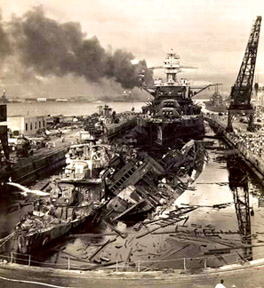Pearl Harbour from their eyes
Captain William Outerbridge:
By T. V. Perera
This eye-witness account of the attack on Pearl
Harbour by the Japanese during World War II, which led to the subsequent
atomic bombs being dropped in Hiroshima and Nagasaki by the Americans,
is by Captain William Outerbridge of the US Navy who sank a Japanese
Submarine close to the entrance to Pearl Harbour in which the American
battle-ships were anchored.

A bomb exploding at Pearl Harbour

Ships that were hit

Attack on the planes |
William outerbridge was the captain of the destroyer USS Ward, whose
task was to patrol the entrance to Pearl Harbour. On the morning of
December 7, 1941, just hours before the air attack, a Japanese submarine
was spotted there. The ward sank it, earning captain outbridge the Navy
cross.
“We went to sea on the morning of December 6. We were prepared to
open fire, we were prepared to drop depth-charges we were prepared for
any eventuality within the ship’s capabilities. Everything went well.
The harbour was a beautiful sight from the sea, and drifting across the
buoys listening for submarines seemed a comparatively easy task.
Unforgettable day
 |
|
Attack on ship |
On the morning of the 7th at about 0358 the mine-sweepers which had
come out at two o’clock in the morning were on station sweeping the
channel with their mine-sweeping gear. At 0358 a flashing light signal
was received from the condor.
This said in effect, ‘we have sighted a suspicious object which looks
like a submarine. It appears to be standing to the westward of our
present position’.
The search revealed nothing. We did not locate the submarine.
Therefore, I had the ship secured from general quarters, and told the
Executive Officer, Lieutenant H. T. Doughty, to let the boys sleep in
the next morning.
I turned in, but at about 6.30 in the morning Lieutenant O. W.
Goepner, the Gunnery Officer, awakened me.
He was rather abrupt. ‘Captain, come on the bridge’ – I scolded him
for talking to the captain like that, but I did not go to the bridge as
fast as I could.
We spotted what looked like a buoy, but it was moving. I looked at it
and said ‘Goepner, I believe that is a submarine. Go to general quarters
and tell him that if it is a submarine we would attack.
So he went to his battle station, and had all the guns loaded. We had
all the depth charges on ‘ready’.
We bore down on the object, all that we could make on two boilers
which was a little bit better than 20knots. As we bore down on it, I
decided not to ram – I didn’t know how big it was, I didn’t know what it
was, and I was afraid that if we hit it we would tear the bottom out of
our ship. I decided to shoot and drop depth-charges on it.
We opened fire when within about 75 yards of the submarine. Gun one
fired first, and missed, gun three fired next. The shell from gun three
struck the submarine at the waterline, which was at the base of the
conning tower where the conning tower joins the hull of the submarine.
There was a light feather of water when the shell hit, and it
appeared to us to have successfully penetrated the target. Several
observers on board ship said that they saw a hole in the submarine.
We passed across the submarine’s course so close that the men on the
fantail and on gun four thought we were going to ram.
In crossing ahead we dropped four depth charges which exploded at the
depth at which they were set to explode and the submarine then appeared
to sink. After we had completed the attack we noticed a sampan in the
restricted area. This was a white fishing vessel, operated by the
Japanese. We turned to the sampan and started after it. As we closed on
the sampan, which was headed to Barber’s Point, it hove to.
We went alongside and a Japanese came out waving for the coast guard,
and one of their ships came out of the harbour and escorted the sampan
back to safety away from the restricted area.
We returned to our station, and picked up another sound contact which
we bombed and reported. Executive Officer Doughty was standing on the
bridge and we were considering securing from general quarters.
It was then about 7.50 a.m. Then we heard explosions, and Doughty
said to me they were over on the beach. I said ‘Well, that’s probably
that superhighway that’s being built between Pearl Harbour and Honolulu,
they are probably blasting early this morning.’ Then Doughty said ‘No,
It’s not. Look over there. There are some planes coming straight down.
It appears to me that they’re bombing the place’. And I said, ‘My gosh,
they certainly are.’ And that moment was our first indication of the
attack on Pearl Harbour.” |



